By Leen Randell
Updated: Jul 04, 2024
10 Best Herbal Decoctions For Bee Sting
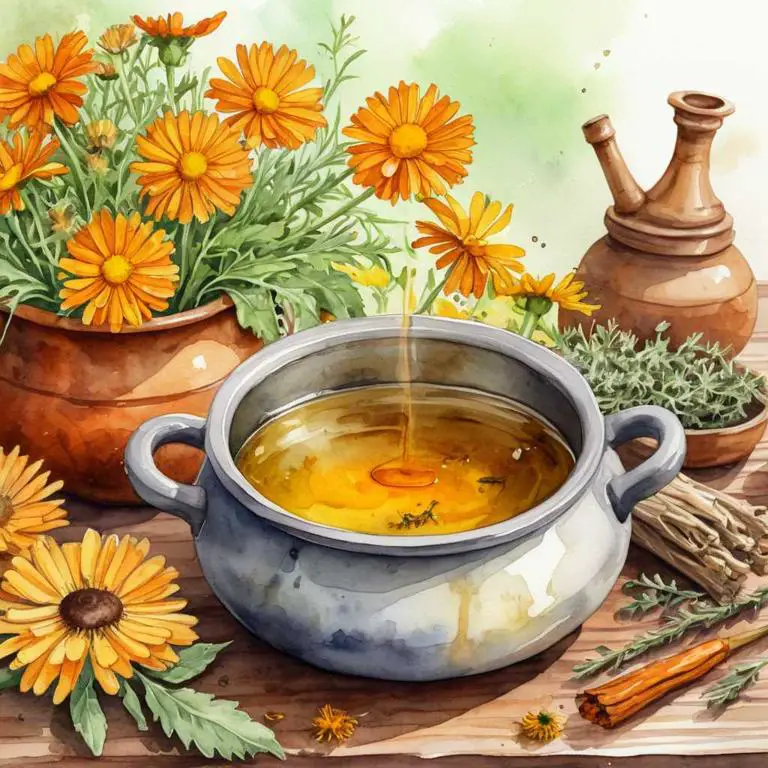
Herbal decoctions for bee sting are a natural remedy used to alleviate pain, swelling, and inflammation caused by bee stings.
These decoctions are made by steeping herbs in hot water, releasing their active compounds that help to soothe the affected area. Examples of herbal decoctions that have been used to treat bee stings include those made with plants like plantain, yarrow, and calendula, which have anti-inflammatory and antimicrobial properties.
By using these decoctions, individuals can quickly recover from a bee sting without the need for antihistamines or other medications, improving their overall quality of life and reducing the risk of complications.
The following article describes in detail the most important decoctions for bee sting, including medicinal properties, parts of herbs to use, and recipes for preparations.
- 1. Calendula officinalis
- 2. Hamamelis virginiana
- 3. Hypericum perforatum
- 4. Achillea millefolium
- 5. Echinacea angustifolia
- 6. Plantago major
- 7. Arnica montana
- 8. Bellis perennis
- 9. Taraxacum officinale
- 10. Symphytum officinale
- What is the best combination of herbal decoctions to use for bee sting?
- What ailments similar to bee sting are treated with herbal decoctions?
1. Calendula officinalis
Pot marigold decoctions helps with bee sting because of its anti-inflammatory and antimicrobial properties.
The decoction's flavonoids and phenolic acids work together to reduce swelling, ease pain, and combat infection caused by the bee venom. Additionally, pot marigold's antioxidants help neutralize free radicals that can exacerbate the stinging sensation.
By applying the decoction topically or taking it internally, individuals can experience relief from bee sting discomfort and promote a speedy recovery.

Medicinal Constituents
The list below shows the primary medicinal constituents in Calendula officinalis decoctions that help with bee sting.
- Beta-carotene: This carotenoid helps by reducing inflammation and promoting wound healing, which can alleviate the discomfort and swelling caused by bee stings.
- N-acetylated saponins: These compounds have anti-inflammatory and antimicrobial properties, which help combat the infection and reduce pain caused by bee stings.
- Oleanolic acid: This triterpenoid has anti-inflammatory and antiseptic properties, which help soothe and calm the affected area, reducing redness and swelling associated with bee stings.
Parts Used
The list below shows the primary parts of pot marigold used to make decoctions for bee sting.
- Flowers: They are commonly used to make decoctions for bee stings due to their anti-inflammatory and antiseptic properties.
- Leaves: They are used in decoctions for bee stings to provide additional anti-inflammatory and soothing effects.
- Roots: They are used in decoctions for bee stings to provide a deeper, more prolonged relief from pain and inflammation.
Quick Recipe
The following recipe gives a procedure to make a basic pot marigold for bee sting.
- Gather dried calendula officinalis flowers in a quantity of 10 to 20 grams.
- Boil 1 liter of water for 5 to 7 minutes to reach the optimal temperature.
- Add the dried flowers to the boiling water and steep for 5 to 10 minutes.
- Strain the mixture using a cheesecloth or a fine-mesh sieve to remove the solids.
- Allow the decoction to cool before storing it in a clean glass container.
2. Hamamelis virginiana
American witch hazel decoctions helps with bee sting because of its anti-inflammatory and antiseptic properties.
The astringent nature of witch hazel helps to reduce swelling and alleviate pain caused by bee stings, while also preventing infection from setting in.
The decoction's antibacterial properties also help to combat any existing infections, promoting healing and reducing the risk of further complications.
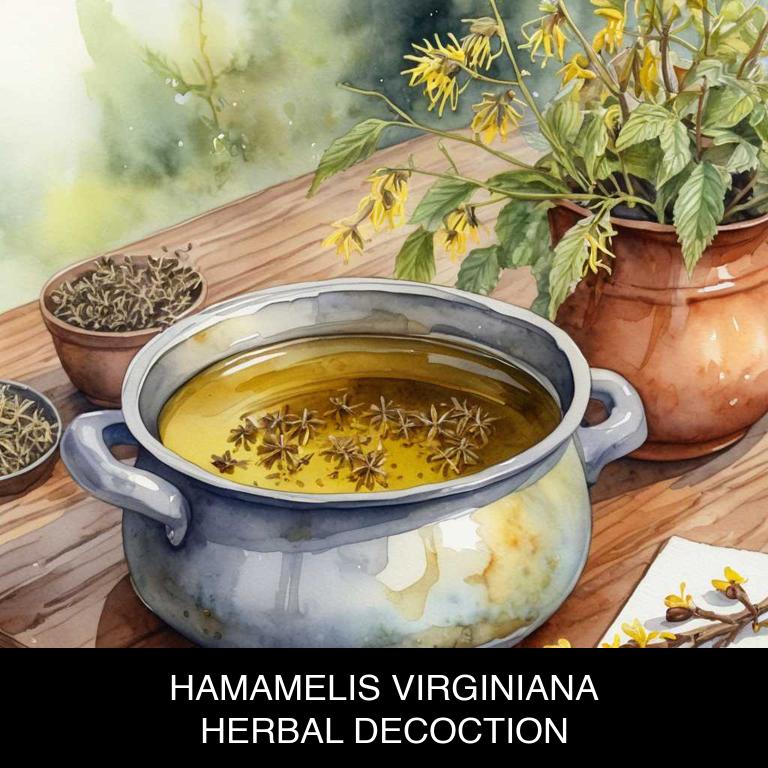
Medicinal Constituents
The list below shows the primary medicinal constituents in Hamamelis virginiana decoctions that help with bee sting.
- Hamamelitannin: It helps with bee stings by acting as a potent astringent and anti-inflammatory agent, which reduces swelling and soothes the skin.
- Flavonoids: They help with bee stings by acting as potent anti-inflammatory and antioxidant agents, which reduce redness, swelling, and pain.
- Tannins: They help with bee stings by forming a protective barrier on the skin, reducing the absorption of venom and thereby alleviating symptoms such as itching, redness, and swelling.
Parts Used
The list below shows the primary parts of american witch hazel used to make decoctions for bee sting.
- Leaves: The leaves' astringent properties are believed to provide relief from itching and inflammation.
- Buds: The buds' astringent and anti-inflammatory properties may help reduce swelling and ease pain.
Quick Recipe
The following recipe gives a procedure to make a basic american witch hazel for bee sting.
- Harvest 1 cup of dried hamamelis virginiana bark from a reliable source by mid-morning.
- Crush the bark into a fine powder using a mortar and pestle for 10 minutes.
- Combine the powder with 2 cups of water in a saucepan and bring to a boil for 5 minutes.
- Reduce heat and simmer for 30 minutes or until the decoction has reduced slightly.
- Strain the decoction through a cheesecloth and discard the solids for 5 minutes.
3. Hypericum perforatum
St John's Wort Decoctions helps with bee sting because its anti-inflammatory and antiseptic properties soothe the affected area, reducing swelling and redness.
The decoction's astringent nature also helps to constrict blood vessels, minimizing further irritation and discomfort. Additionally, St John's Wort's natural antimicrobial agents prevent infection from setting in, allowing for a faster recovery from bee stings.
By providing fast relief and promoting healing, St John's Wort Decoctions offer a natural and effective remedy for bee sting victims.

Medicinal Constituents
The list below shows the primary medicinal constituents in Hypericum perforatum decoctions that help with bee sting.
- Naphthodianthrones: These compounds have anti-inflammatory and antiseptic properties, which help to reduce swelling, redness, and pain associated with bee stings.
- Flavonoids: These flavonoids have anti-inflammatory and antioxidant properties, which help to reduce the severity of bee sting reactions and promote wound healing.
- Phenolic acids: These compounds have antimicrobial and anti-inflammatory properties, which help to prevent infection and reduce inflammation caused by bee stings.
Parts Used
The list below shows the primary parts of st john's wort used to make decoctions for bee sting.
- Leaves: Leaves are the most commonly used part for making decoctions for bee stings due to their high concentration of hypericin and hyperforin, which have anti-inflammatory and antiseptic properties.
- Flowers: Flowers are used due to their high content of flavonoids and phenolic acids, which help to reduce inflammation and promote healing.
- Roots: Roots are also used, as they contain a rich mixture of flavonoids and phenolic acids that aid in reducing inflammation and promoting the healing process.
Quick Recipe
The following recipe gives a procedure to make a basic st john's wort for bee sting.
- Harvest 10 to 20 grams of fresh hypericum perforatum flowers and leaves in the morning.
- Dry the harvested hypericum perforatum flowers and leaves for 7 to 10 days in a warm place.
- Grind 2 to 4 grams of dried hypericum perforatum flowers and leaves into a fine powder.
- Steep 1 gram of the ground hypericum perforatum powder in 250 milliliters of boiling water for 5 to 10 minutes.
- Strain the decoction through a cheesecloth or a fine-mesh sieve into a clean container to discard the solids.
4. Achillea millefolium
Yarrow decoctions helps with bee sting because of its anti-inflammatory and antiseptic properties, which work together to reduce swelling and alleviate pain.
The decoction's active compounds, such as sesquiterpenes and flavonoids, also help to soothe the affected area, neutralize venom, and prevent infection. Additionally, yarrow's natural astringent properties constrict blood vessels, reducing bleeding and promoting faster healing.
As a result, applying a yarrow decoction to a bee sting can provide quick relief from discomfort and promote a healthy recovery.

Medicinal Constituents
The list below shows the primary medicinal constituents in Achillea millefolium decoctions that help with bee sting.
- Apigenin: This flavonoid compound has anti-inflammatory and antihistamine properties, which help to reduce swelling, itching, and pain associated with bee stings.
- Bornyl acetate: As a sesquiterpene, it has analgesic and anti-inflammatory effects, which can help to alleviate pain and reduce the redness and swelling caused by bee stings.
- Chamazulene: This sesquiterpene lactone has anti-inflammatory and antiseptic properties, which can help to soothe and protect the skin from infection and promote healing after a bee sting.
Parts Used
The list below shows the primary parts of yarrow used to make decoctions for bee sting.
- Leaves: They are rich in flavonoids and terpenoids, which are believed to have anti-inflammatory and antiseptic properties that can help soothe bee sting.
- Flowers: The flowers of Achillea millefolium contain sesquiterpene lactones, which are known for their anti-inflammatory and antiseptic properties that can help alleviate bee sting symptoms.
- Stems: The stems of Achillea millefolium are rich in sesquiterpene lactones, which are believed to have anti-inflammatory and antiseptic properties that can help reduce swelling and itching caused by bee stings.
Quick Recipe
The following recipe gives a procedure to make a basic yarrow for bee sting.
- Harvest 1 to 2 handfuls of fresh achillea millefolium leaves and flowers from a clean area.
- Chop the harvested plant material into small pieces and store it in an airtight container immediately.
- Measure out 1 to 2 teaspoons of the chopped plant material for every 250 milliliters of water used.
- Combine the measured plant material and water in a saucepan and bring to a boil over high heat.
- Simmer the decoction for 5 to 10 minutes and then let it steep for another 10 to 15 minutes.
5. Echinacea angustifolia
Kansas coneflower decoctions helps with bee sting because its anti-inflammatory properties reduce swelling and pain.
The decoction's antimicrobial properties also help prevent infection by killing bacteria that can enter the wound through the sting. Additionally, the decoction's antihistamine-like effects alleviate itching and redness caused by an allergic reaction to the sting.
As a natural remedy, Kansas coneflower decoctions provide effective relief from bee stings, promoting a quicker recovery and reducing the risk of complications.

Medicinal Constituents
The list below shows the primary medicinal constituents in Echinacea angustifolia decoctions that help with bee sting.
- Iridoids: Iridoids, such as echinacoside, are known for their anti-inflammatory properties, which can help alleviate pain and swelling caused by bee stings.
- Phenylpropanoids: Phenylpropanoids, including caftaric acid, have antioxidant and anti-inflammatory effects, which can aid in reducing the severity of bee sting reactions and promoting healing.
- Alkamides: Alkamides, such as echinulin, have been shown to exhibit anti-inflammatory and immunomodulatory activities, which can help regulate the body's response to bee stings and reduce the risk of anaphylaxis.
Parts Used
The list below shows the primary parts of kansas coneflower used to make decoctions for bee sting.
- Roots: The roots of Echinacea angustifolia are primarily used to make decoctions for bee sting due to their high concentration of iodosomal and sesquiterpene compounds, which have anti-inflammatory properties.
- Roots: The roots are also used to make decoctions for bee sting because they are rich in alkylamides and phenylethanoid glycosides, which have shown to reduce inflammation and pain.
- Roots: The roots are used to make decoctions for bee sting because they contain echinulin, a sesquiterpene compound with anti-inflammatory and antiseptic properties.
Quick Recipe
The following recipe gives a procedure to make a basic kansas coneflower for bee sting.
- Harvest the roots of echinacea angustifolia in late summer or early fall when they are mature and dry.
- Clean the roots thoroughly and chop them into small pieces to increase their surface area.
- Combine 2-4 grams of chopped echinacea angustifolia roots with 1 liter of boiling water to create the decoction.
- Simmer the mixture for 5-10 minutes to release the active compounds into the water.
- Strain the decoction through a cheesecloth or a coffee filter to remove the solids and discard the roots.
6. Plantago major
Plantain decoctions helps with bee sting because of its anti-inflammatory and antiseptic properties.
The plant's bioactive compounds, such as aucubin and platycodin, work to reduce swelling, itching, and redness caused by the sting. When applied topically or ingested in a decoction, plantain can help soothe the affected area, ease pain, and promote healing.
Its natural antimicrobial properties also prevent infection and speed up the recovery process, making it an effective remedy for bee stings.
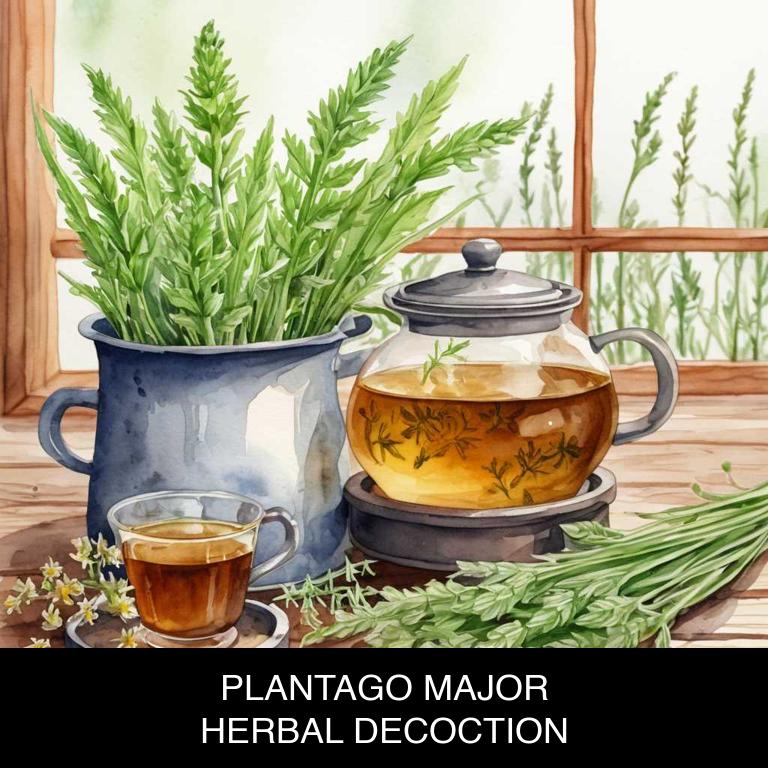
Medicinal Constituents
The list below shows the primary medicinal constituents in Plantago major decoctions that help with bee sting.
- Flavonoids: These plant-derived compounds have anti-inflammatory properties, which can help alleviate pain and reduce swelling caused by bee stings.
- Phenolic acids: Phenolic acids in Plantago major have antioxidant and anti-inflammatory effects, which can help neutralize the venom of bee stings and promote healing.
- Apolenin: Apolenin, a lignan glycoside, has been reported to have anti-inflammatory and analgesic properties, which can help soothe the pain and inflammation associated with bee stings.
Parts Used
The list below shows the primary parts of plantain used to make decoctions for bee sting.
- Leaves: They are rich in mucilage, which helps to soothe and reduce inflammation.
- Roots: They contain compounds like aucubin and catalpol, which have anti-inflammatory and pain-relieving properties.
Quick Recipe
The following recipe gives a procedure to make a basic plantain for bee sting.
- Harvest 20-30 grams of fresh plantago major leaves and flowers in the early morning.
- Dry the harvested plantago major leaves and flowers in a warm dark place for 2-3 weeks.
- Chop 10-20 grams of dried plantago major leaves and flowers into smaller pieces.
- Steep the chopped dried plantago major leaves and flowers in 500ml of boiling water for 5-7 minutes.
- Strain the herbal decoction through a cheesecloth or a coffee filter into a clean container.
7. Arnica montana
Mountain arnica decoctions helps with bee sting because of its anti-inflammatory properties, which quickly soothe the affected area.
The decoction's active ingredients, such as helenin and flavonoids, reduce swelling and relieve pain caused by the venom injection. Additionally, arnica has antiseptic and antimicrobial properties that prevent infection and promote wound healing.
As a result, mountain arnica decoctions provide rapid relief from bee sting symptoms, allowing for a quicker recovery and minimizing discomfort.
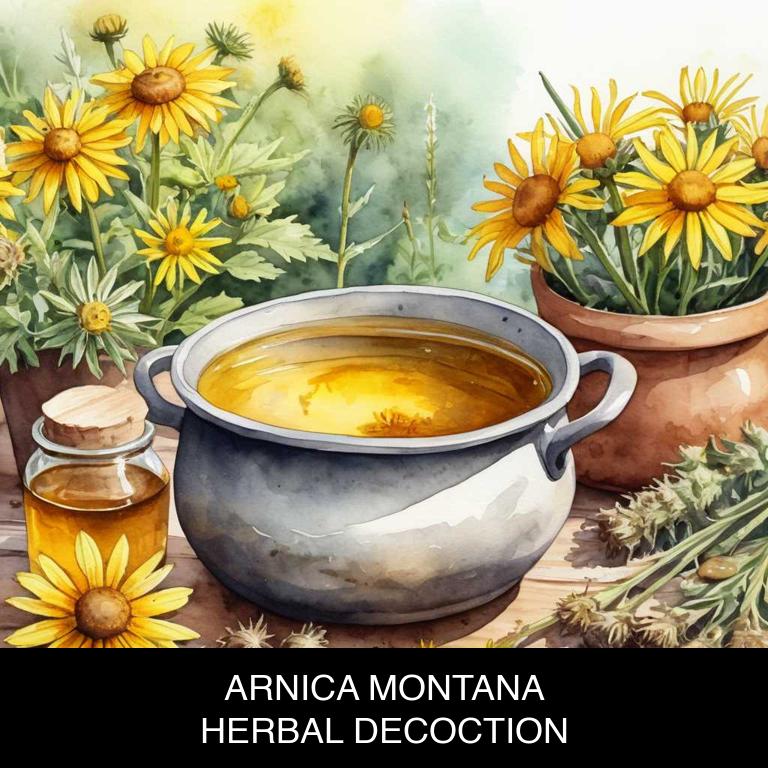
Medicinal Constituents
The list below shows the primary medicinal constituents in Arnica montana decoctions that help with bee sting.
- Terpenes: These compounds help reduce inflammation and pain by inhibiting the production of pro-inflammatory enzymes.
- Helenalin: This sesquiterpene lactone compound has anti-inflammatory properties, which can help alleviate pain and swelling caused by bee stings.
- Caffeic acid derivatives: These phenolic compounds have potent anti-inflammatory and antioxidant effects, which can help reduce redness, swelling, and pain associated with bee stings.
Parts Used
The list below shows the primary parts of mountain arnica used to make decoctions for bee sting.
- Flowers: They are the most commonly used part due to their high concentration of sesquiterpene lactones, which have anti-inflammatory properties.
- Leaves: Leaves are another primary source of sesquiterpene lactones, contributing to their effectiveness in treating bee stings.
- Roots: Roots of Arnica montana contain sesquiterpene lactones as well, making them a valuable part for decoctions to alleviate bee sting pain and swelling.
Quick Recipe
The following recipe gives a procedure to make a basic mountain arnica for bee sting.
- Harvest arnica montana flowers at the peak of bloom to ensure optimal potency and flavor.
- Dry the fresh flowers in a warm place with good air circulation for 7 to 10 days.
- Combine 1 part dried arnica montana flowers with 1 part water in a saucepan to create a decoction.
- Heat the mixture over low heat for 10 to 15 minutes allowing the flowers to infuse their properties.
- Strain the decoction through a cheesecloth or a fine mesh to separate the liquid from the solids.
8. Bellis perennis
Daisy decoctions helps with bee sting because it possesses natural anti-inflammatory and antibacterial properties that help to soothe the affected area.
The decoction's cooling effect reduces swelling and ease pain, while its antimicrobial properties prevent infection and promote healing. Additionally, daisy decoctions contain antioxidants that neutralize free radicals and reduce inflammation, making it an effective remedy for bee sting relief.
As a result, applying daisy decoctions to the affected area can provide rapid and natural relief from bee stings.
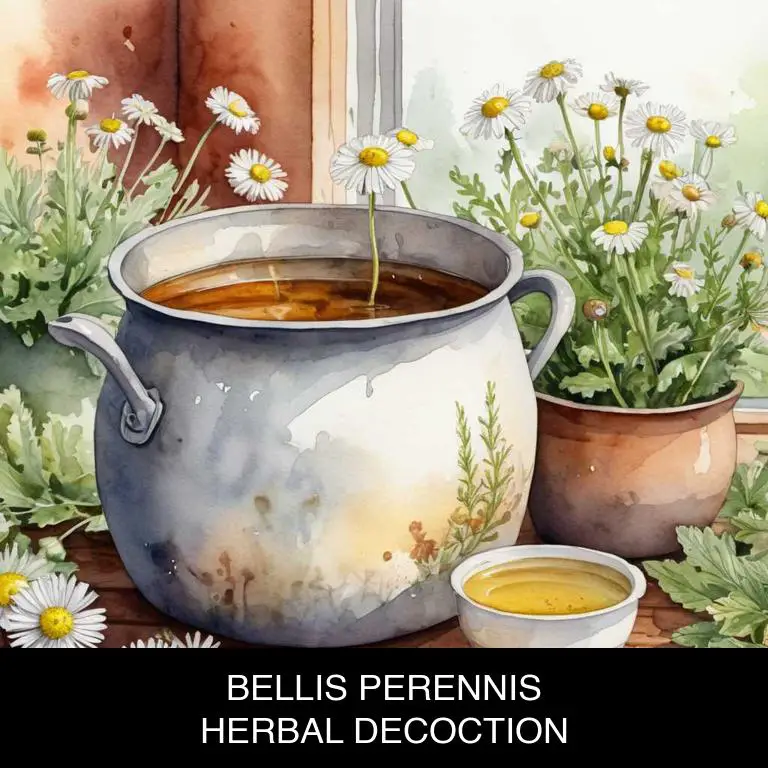
Medicinal Constituents
The list below shows the primary medicinal constituents in Bellis perennis decoctions that help with bee sting.
- Tannins: They help to reduce inflammation and neutralize the acid in bee venom, providing relief from pain and swelling.
- Flavonoids: These compounds have anti-inflammatory and antioxidant properties, which can help to alleviate the redness and swelling caused by bee stings.
- Saponins: They have anti-inflammatory and antiseptic properties, which can help to soothe and protect the skin from infection after a bee sting.
Parts Used
The list below shows the primary parts of daisy used to make decoctions for bee sting.
- Leaves: They are used due to their anti-inflammatory and soothing properties.
- Roots: The roots of Bellis perennis contain compounds that help reduce pain and swelling associated with bee stings.
- Flowers: Bellis perennis flowers are used to make decoctions due to their potential to reduce allergic reactions and inflammation caused by bee stings.
Quick Recipe
The following recipe gives a procedure to make a basic daisy for bee sting.
- Harvest 25-30 grams of fresh bellis perennis flowers on a sunny day in mid-summer.
- Clean the collected flowers thoroughly to remove any debris or contaminants from the environment.
- Combine the cleaned flowers with 500 milliliters of water in a saucepan and bring to a boil.
- Reduce heat and simmer the mixture for 10-15 minutes or until the liquid has reduced slightly.
- Strain the decoction through a cheesecloth or a fine-mesh sieve into a clean container.
9. Taraxacum officinale
Dandelion decoctions helps with bee sting because of its anti-inflammatory properties, which quickly reduce swelling and itching caused by the venom.
The decoction's antihistamine effects also help alleviate discomfort and relieve itchy skin. Additionally, dandelion's natural antibacterial agents prevent infection from setting in, promoting a rapid recovery.
As a result, dandelion decoctions provide swift and effective relief from bee sting symptoms, soothing the affected area and restoring comfort.

Medicinal Constituents
The list below shows the primary medicinal constituents in Taraxacum officinale decoctions that help with bee sting.
- Inulin: Inulin helps by reducing the inflammation and swelling associated with bee stings, thus alleviating the pain and discomfort.
- Taraxasterol: Taraxasterol exhibits anti-inflammatory and antioxidant properties, which aid in neutralizing the venom and reducing the severity of the sting's effects.
- Luteolin: Luteolin has anti-inflammatory and antihistamine properties, which help to alleviate the allergic reactions and itching caused by bee venom, making it a key constituent in soothing bee sting symptoms.
Parts Used
The list below shows the primary parts of dandelion used to make decoctions for bee sting.
- Leaves: The leaves are used due to their anti-inflammatory properties, which help soothe the pain and swelling caused by bee stings.
- Roots: The roots are used for their anti-inflammatory and antiseptic properties, which aid in reducing the pain and preventing infection from bee stings.
- Flowers: The flowers are used for their anti-inflammatory and analgesic properties, which help alleviate the pain and discomfort caused by bee stings.
Quick Recipe
The following recipe gives a procedure to make a basic dandelion for bee sting.
- Harvest taraxacum officinale roots in the fall after the first frost and dry them completely.
- Measure out 10-20 grams of dried taraxacum officinale root for a standard decoction serving.
- Combine the dried root with 1 liter of water in a saucepan and bring to a boil.
- Reduce the heat and simmer the mixture for 10-15 minutes or until the liquid has reduced slightly.
- Strain the decoction through a cheesecloth or fine-mesh sieve into a clean container.
10. Symphytum officinale
Comfrey decoctions helps with bee sting because it possesses anti-inflammatory and antiseptic properties that can effectively soothe and calm the affected area.
The allantoin present in comfrey has been shown to promote healing, reduce swelling, and ease pain caused by bee stings. Additionally, comfrey's antimicrobial agents help prevent infection and speed up the recovery process.
By applying a comfrey decoction to the sting site, individuals can alleviate discomfort, reduce redness, and promote healthy healing.
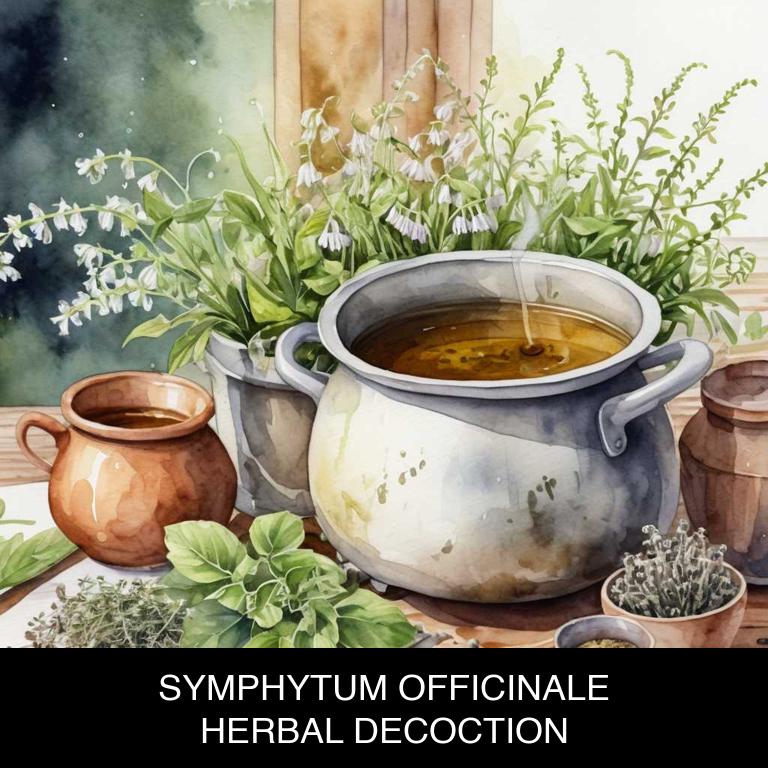
Medicinal Constituents
The list below shows the primary medicinal constituents in Symphytum officinale decoctions that help with bee sting.
- Alkaloids: Alkaloids present in Symphytum officinale, particularly planteose, help alleviate bee sting pain by acting as natural analgesics and reducing inflammation.
- Flavonoids: Flavonoids, such as quercetin, in Symphytum officinale decoctions help mitigate bee sting symptoms by reducing histamine release and alleviating allergic reactions.
- Saponins: Saponins in Symphytum officinale help neutralize the venom from bee stings by creating a barrier that prevents the venom from entering the skin and causing further irritation.
Parts Used
The list below shows the primary parts of comfrey used to make decoctions for bee sting.
- Leaves: They are used due to their anti-inflammatory properties, which help alleviate pain and reduce swelling caused by bee stings.
- Roots: They contain compounds that have anti-inflammatory and antiseptic effects, making them effective in treating bee sting reactions.
- Stems: They also contain anti-inflammatory compounds, which can help soothe and calm the skin after a bee sting.
Quick Recipe
The following recipe gives a procedure to make a basic comfrey for bee sting.
- Harvest 30-60 grams of dried or 60-120 grams of fresh roots of symphytum officinale.
- Cut the roots into smaller pieces to increase their surface area for better extraction.
- Combine the roots with 1 liter of cold water in a saucepan to make a decoction.
- Boil the mixture over high heat for 5-10 minutes then reduce heat to a simmer.
- Strain the liquid through a cheesecloth or a coffee filter into a separate container.
What is the best combination of herbal decoctions to use for bee sting?
The best combination of herbal decoctions that help with bee sting is a blend of plantain, calendula, and aloe vera.
Plantain helps to neutralize the venom, while calendula reduces inflammation and promotes healing. Aloe vera soothes the skin and reduces pain. To make this decoction, combine equal parts of dried plantain and calendula leaves, then add aloe vera gel.
Steep the mixture in hot water, strain, and apply it to the affected area to alleviate pain and promote healing.
What ailments similar to bee sting are treated with herbal decoctions?
Ailments similar to bee sting that are treated with herbal decoctions are various skin irritations and allergic reactions, such as nettle rash, mosquito bites, and poison ivy.
Decoctions made from herbs like calendula, plantain, and witch hazel have anti-inflammatory properties that help soothe itchy and inflamed skin, reducing redness and swelling.
These herbal remedies can provide relief from the discomfort and irritation caused by these common summer ailments.